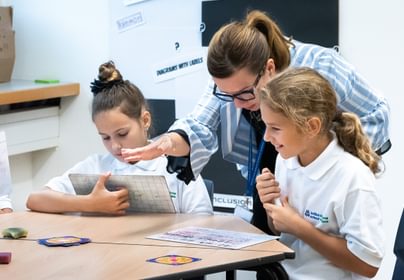Non Verbal communication
Have you ever wondered why children behave so differently when they are with some adults?
Or why they do exactly what their teacher tells them but exactly the opposite of what you want them to do?
At The British International School of Ljubljana, we believe in trying a range of ‘Behaviour for Learning’ Strategies, to best engage the students at school. We are passionate about finding the best possible techniques that work with all of our students, both as individuals, in groups and also across the different age ranges.
These strategies are essential for any parent or teacher and come in many forms . Teachers use learning routines, rewards and sanctions or positive reinforcement and verbal cues. Sometimes though, words are not necessary at all.
We all use non verbal communication everyday but the more aware of them we become the more effective they can be. Here are a few of the most common non verbal cues.
Positive Force Field
This is probably the most obvious nonverbal cue of them all. Positive body language cues lower anxiety and boost motivation. Children feel more secure and engaged in the lessons or safe and secure at home.
Proxemics
Proxemics is the study of how space is utilised and applied. How close or far away should you be from the children in your care? How far away do you have to be for their behaviour to change?
Facial Expression
Many teachers could have a second career as mime artists as they have the ability to show sadness, happiness and sympathy at a whim. It’s amazing what difference a smile can make but be careful ….children learn this trick very quickly as well!
Eye talk
You might think that the eyes can’t utter words and sentences, On the contrary, a single look can convey so much. Every child recognises that special look, ‘The look’ that makes time stand still for a moment , the look given by a teacher or parent, that speaks a thousand words. Have you ever practised your look in the mirror?
Gesture and sign language
Gestures and sign language are extremely useful non verbal cues. Many teachers will teach their class a few simple signs to save time. However, every well travelled international teacher knows that gestures are not universal. For example, in the United Kingdom ‘fingers crossed’ means good luck but in Vietnam it means something completely different!
Anchoring
Have you ever wondered why advertisers use celebrities to promote their products? It is because they want us to associate the two.
Anchoring is a technique rooted in the Pavlovian conditioning tradition where a stimulus can evoke a specific response. For example , when I was growing up my mother used a cowbell to let me know that dinner was on the table. Consequently, walks in Slovenia’s cow laden mountain pastures usually make me very hungry!
Teachers use a range of anchoring techniques in the classroom. All sorts of everyday objects like sponges, balls, toys can be linked / anchored to a certain behaviour. This is why children can become so attached to comfort blankets or cuddly toys that have become breeding grounds for next great plague!
Perhaps it is time for us all to reflect on our non -verbal communication? What secret signals are you giving to your children? What signals are they giving to you?



